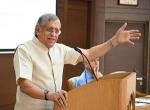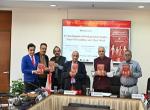The III Edition of Samvad at Ulaanbaatar was a great success in many ways. In particular it cemented the relation between India and Mongolia as Spiritual Partners. It was held in the premises of Gandan Monastery in Ulaanbaatar.
The pre - inaugural session was dominated by the Buddhist spirit at its best with a large crowd of couple of hundreds attending the rituals and opening of the gates of the new Gandan Monastery. The atmosphere was festive with colourful traditional arts and music at display. The music and dance bore a lot of resemblance to that of NE India. UNlCEF Goodwill Ambassador from Nepal, a Buddhist Nun, sang the Ganesh Stuti. Buddhist Spiritual Masters, Scholars, Policy Influencers from Sri Lanka, Bhutan, Nepal, Myanmar, Vietnam, Russia, Cambodia, Thailand, South Korea, Hong Kong and Japan participated in Samvad III along with the Mongolian and the Indian side.
The Prime Minister of Mongolia represented the Mongolian side. The entire proceedings had the blessings of His Eminence Khamba Lama, the Supreme Monk of Gandan Monastery.
Prime Minister of India, Mr Narendra Modi gave a special video message for the occasion.
Mr. S Gurumurthy, Chairman of the VIF and Ku Nivedita Bhide one of its trustees led the Indian delegation. Mr. Sushil Modi, Deputy Chief Minister of Bihar, Dr Vinay Sahasrabuddhe, Member of Parliament (Rajya Sabha) & President, ICCR and Ladakh MP Mr. Jamyang Tsering Namgyal were special nominees of the Prime Minister of India. Three eminent Indian religious and spiritual masters participated in the three days proceedings: Sri Sri Ravi Shankar, Pujya Sri Avedshananada Giri ji and Pujya Sri Mitrananda.
Dr Swapan Dasgupta, MP, Balbir Punj, Former MP and Dr Anirban Ganguly, Director-SPMRF spoke at various sessions and interacted with the Mongolian academia, civil society representatives and students.
The VIF organising team was headed by its Secretary Smt Anuttama Ganguly.
From the Japanese side besides the Shinto-Buddhist religious scholars, academicians and the Japanese Foundation officials, the Ambassador of Japan to Mongolia participated and read PM Abe’s message.
Read here : PM Abe’s text Message
Samvad III was divided in two parts, a round table of Religious and Spiritual Masters and a parallel session on the aspects of Conflict Avoidance, Shared Values, Democracy and Environmental Consciousness.
Religious Round Table [RRT]
The RRT is a path breaking exercise which was introduced to carry forward the theme of Conflict Avoidance articulated in the concept paper of Samvad, which was delivered as the keynote address at Samvad I in 2015 at New Delhi by Shri S Gurumurthy.
The concept paper had alluded to the Hindu-Buddhist traditional dialogue model of Tarka Shastra and Purva Paksha among scholars to question the premises and foundations of the other faiths to seek clarity and to avoid conflicts that arise because of the miscommunication and misinterpretation by religious scholars themselves. The Hindu-Buddhist model is different and is termed as inter-faith dialogue. It is an open and frank expression of misgivings of one faith about the other so as to remove the misgivings and to ensure no one in any way spreads violent ideas as legitimate theological position of a religion. The Hindu Buddhist dialogues had effectively prevented any mass religious or other killings in India till the 13th century.
The Indian way of dialogue is effective in avoiding conflicts and ensuring that religions grow as philosophical religions which are willing to engage in dialogue over their foundations and not as ideological religions that do not. Swami Vivekananda had indirectly introduced the Purva Paksha model in the World Parliament of Religions and directly in his talks thereafter. But for a whole century the world dismissed religion as a factor and the need for dialogue among them for peace and harmony till mid 1990s when two conflicting views of end of conflicts as Francis Fukuyama theorised or re-beginning of religious conflicts as Samuel Huntington hypothesised, emerged. It was then that the Harvard University thought it fit to commence the Religious Pluralism Project recalling the 1893 World Parliament of Religions.
Yet there has been no effort for open discussions on the foundations of different faiths which affect the relation between faiths and therefore between peoples. This is despite the fact that a wealth of literature on religious fundamentalism and extremism had emerged through the
Fundamentalism Project of the American Academy of Arts and Science [Chicago University Press] in the late 1980s and early 1990s. Simultaneously, Hans Kung, a well-known Catholic theologian, formulated a rule for inter-religious dialogue which is identical to the Hindu-Buddhist concept of Tarka Shastra and Purva Paksha. Hans Kung formulated: “No peace among the nations without peace among the religions; No peace among the religions without dialogue between the religions; No dialogue between the religions, without investigation of the foundations of the religions.”
The concept paper of Samvad I is founded on the Hindu Buddhist dialogue discipline of Tarka and Purva Paksha as formulated by Hans Kung. It was the in Samvad II that the VIF thought it would be necessary to start honest and open dialogue among faiths. In Samvad II besides Hindu Buddhist spiritual masters, Muslims and Christian religious leaders also participated. They could openly discuss the concept and terminology of one faith which could create apprehensions in the mind of the followers of other faiths. The leaders who participated in the discussions were very enthused by the format of the dialogue. After the Myanmar dialogue there was also a follow up dialogue in India. This dialogue was conducted and moderated by Swami Mitrananda of Chinmaya Mission.
The Ulaanbaatar Samvad III took the concept to another level. Issues relating to what is the concept of Kafir, Jihad, Heathen, Crusade, Conversions were discussed in detail. The discussions touched upon the need for faiths to move away from Only to Also, and Conversion to Conversation. One of the important effects of the RRT in Myanmar was the message of Daw Aung San Sui Kyi, the State Counsellor of The Republic of the Union of Myanmar to the Ulaanbaatar meet where she specifically said:
“[S]ome of the responsible religionists do not take interest in imparting knowledge of the genuine knowledge of the genuine teachings shown by their respective religions. Moreover, some even lead their followers to the wrong way by means of instructing then bogus and insincere doctrines under the name of religion.”
Read here : Message of Aung San Suu Kyi
Technical session on Conflict Avoidance, Shared Values, Democracy and Environmental Consciousness
The parallel technical sessions, the mainstay of the conference with the themes of Shared Values, Democracy and Environmental Consciousness besides Conflict Avoidance saw participation by a large number of spiritual masters and also by academics, thinkers, policy makers and leaders.
The parallel sessions on both days had interesting themes, themes which essentially defined the deliberations and the sharing of views and experiences in Samvad. One session had as its theme, 'Conflict Avoidance" and "Shared Values and Democracy in Asia", while the other session had "Environment Consciousness" and "Conflict Avoidance." These sessions saw as speakers members of Parliament from India, Sri Lanka and Mongolia, officials from various agencies and bodies of the United Nations such as UNDP and UNICEF, scholars from Bhutan, from Harvard University, from South Korea, from the National University of Mongolia, the nodal social science research body in Mongolia Academy of Sciences. On day two, the environment and tourism Minister of Mongolia, Mr N Tserenbat delivered a special address and spoke on the "The Green Passport Campaign", a very interesting and unique initiative in Mongolia to spread environmental consciousness, awareness, responsibility and sensitivity among citizens and especially the youth and children.
A number of ideas and themes were discussed, the vision of shared values, leadership, governance and environmental conservation in Asia, the increasing and perennial relevance of Swami Vivekananda’s message especially in the context of conflict avoidance, the articulation of a narrative of a free and open Indo-Pacific, the need to address environmental challenges, challenges emanating from terrorism, from an increasing imbalance in our collective existence, the need for a new geo-strategic and cultural vision for the region, the 21st century being the Asian century with Buddha's message being one of its defining cores and many such themes were discussed and deliberated upon. The transformative governance initiatives in India, their origin from the philosophy of compassion - Karuna, Prime Minister Modi's efforts to transform India - through inclusion and empowerment, through peoples' power and participation, the Indian approach to environmental consciousness, the works of Mongolian monks in environmental conservation were some of the topics that the speaker's focused on.
The idea that along with rights, citizens globally need to be made aware of the concept of duties - that along with Lokatantra - democracy, there needed to be Lokakartavya - duty towards one's society, milieu, people and country also came up in the discussions. The views that there can be no hegemony in terms of the flow of ideas, freedom of following one's ways of life and worship and that Asia and the eastern wisdom - flowing from Buddhist and Hindu philosophies and traditions - paramparas - was emphasised and discussed. The perception was also that sharing of experience in terms of governance and environmental initiatives was essential for evolving and articulating a new narrative of engagement.
At the end of the two-day deliberations in Ulaanbaatar, a Declaration was made which captured the essence of the discussions at RRT and RTEC. The same is reproduced below-
ULAANBATAAR DECLARATION 2019
Two Round Tables were organised as part of the Samvad Global Hindu-Buddhist Initiative for Conflict Avoidance, Inter-Religious Understanding and Interdependent Sustainability being held in Ulaanbaatar Mongolia on September 6 and 7, 2019. One was the Religious Round Table on Conflict Avoidance and Inter-Religious Understanding and the other was the Round Table on Environmental Consciousness and Interdependent Sustainability.
The Religious Round Table [RRT] expresses its deep concern over the propensity and potential for conflicts and also the declining environment both of which pose increasing challenges to global peace and prosperity.
The RRT of the religious leaders and scholars is of the view that the leaders of different faiths owe a responsibility to promote conflict avoidance and environmental consciousness.
During the discussions the tendency among some faiths to divide the people as faithful’s and non-believers with attendant ‘divine’, mandate to convert ‘non- believers’ into ‘believers’ was pointed out as one of the principal causes for conflicts. The RRT felt that unless this is checked, it will tend to promote the propensity among powerful sections of them to push their ‘divine' agenda, against such ‘believers’ either trying to buy ‘non-believers’ or exterminate them through extremism and terror. This obviously leads to endless conflicts and violence in the world.
Her Excellency Daw Aung San Sui Kyi, the State Counsellor of The Republic of the Union of Myanmar, has sent a message to the Ulaanbaatar Initiative. The RRT considers the following parts of her message relevant in the context of its discussions and also the current challenges -
Quote
[S]ome of the responsible religionists do not take interest in imparting knowledge of the genuine knowledge of the genuine teachings shown by their respective religions. Moreover, some even lead their followers to the wrong way by means of instructing then bogus and insincere doctrines under the name of religion.
Unquote
The RRT discussed the different terminologies employed by different religions to distinguish between their faithful’s and others which leads to how the faith and the faithfuls should perceive them and treat them. The RRT feels that the religious leaders and scholars should review the use of those terms so as to remove the apprehensions in the minds of the other faiths and their followers about the intent of the terms employed.
The RRT also is of the view that dialogue among religions is inevitable for conflict avoidance. The RRT is inclined to adopt that formula of the Catholic Theologian Hans Kung for dialogue. Hans Kung said that
"Unless their peace between religions there can be no peace between nations.
Two, there cannot be peace between religions unless there is dialogue among religions.
And, three, there cannot be meaningful dialogue among religions unless the foundations of each religion are researched."
The Hans Kung principles were originally to be found in the Hindu Buddhist dialogue discipline of Tarka Shastra and Purva Paksha which both of them employed to debate their differences. One of the reasons for the lack of violence among religions in the Hindu Buddhist civilisations has been the practice of dialogue.
The RRT feels that unless the differences among religions are discussed and debated in dialogues like Samvad, the differences will be settled in streets.
The RRT is of the view that in the contemporary world no religion can claim exclusivity and assert that its fundamentals cannot be questioned by other faiths, particularly if such fundamentals affect the other faiths and their adherents.
The RRT therefore commends that all religions need to foster the discipline of dialogue within and develop internal tolerance without which there cannot be external tolerance.
The RRT appeals to all religious leaders that we need to build a tolerant world first and then move towards a world where each religion accepts that other religions are also capable of leading human beings to good conduct and salvation.
The RRT expresses the hope that the different religions will adopt initiatives like Samvad and RRT to carry forward the consensus reached in Ulaanbaatar.
The RT of Environmental Consciousness and Interdependent Sustainability is of the view that in the name of ‘development’ Mother Nature continues to be abused. As a result, large parts of the globe are regularly under drought or floods. Our rivers and lakes are more polluted than ever before. Even the survival of marine life in fathomless oceans is threatened by senseless dumping of waste by humans.
The reckless exploitation of natural resources over centuries has brought the Mother Earth to a dangerous pass. Can humanity be safe, if the survival of the planet itself is in danger? The RT feels that religions should propagate the environment friendly texts in their religions and should do away and drop the aspects of the text which are environmentally not compatible.
The RT is of the view that role of traditional wisdom and faiths in pursuing sustainable development has not been fully appreciated so far. This conference stresses the need to secure indigenous faiths and practices which invariably are eco-friendly.
The RT is convinced that the local practices and traditions are usually the result of centuries of interaction and interplay between humans and nature. Any alien efforts in the name of ‘civilising’ the locals or ‘development’ disrupts this beautiful relationship and leads to disaster.
The RT urges that the religions work to rein in human greed, respect Mother Nature and recognise and appreciate the role of traditional societies in maintaining the ecological balance.







Post new comment